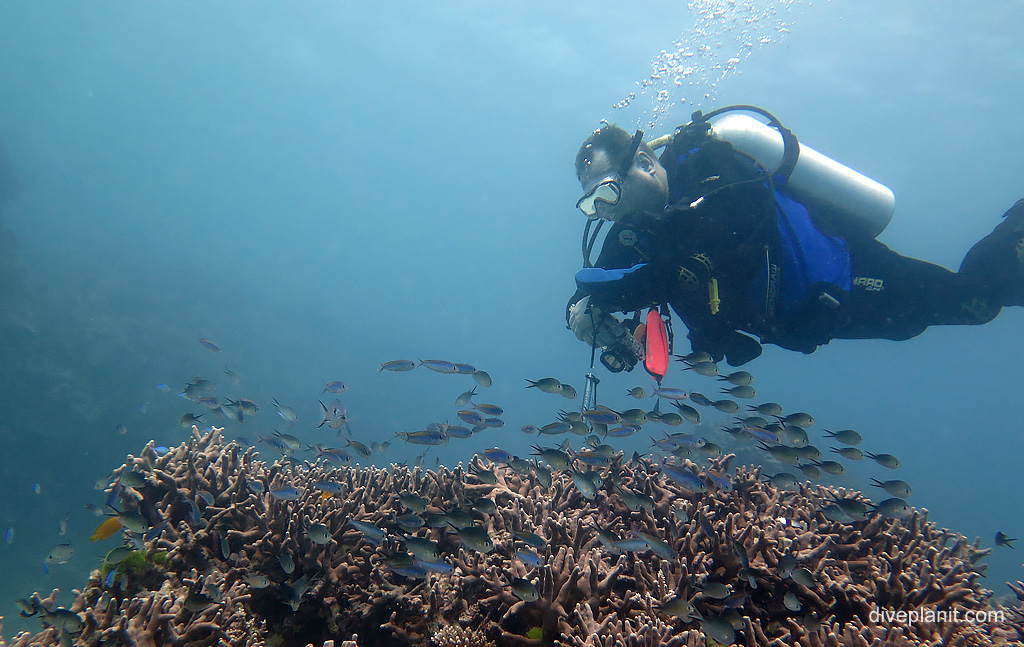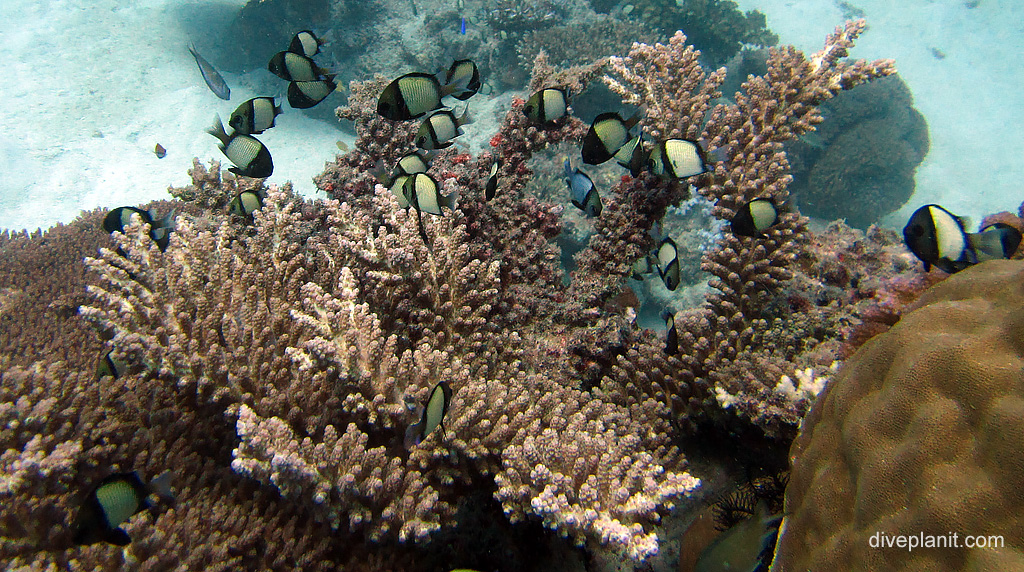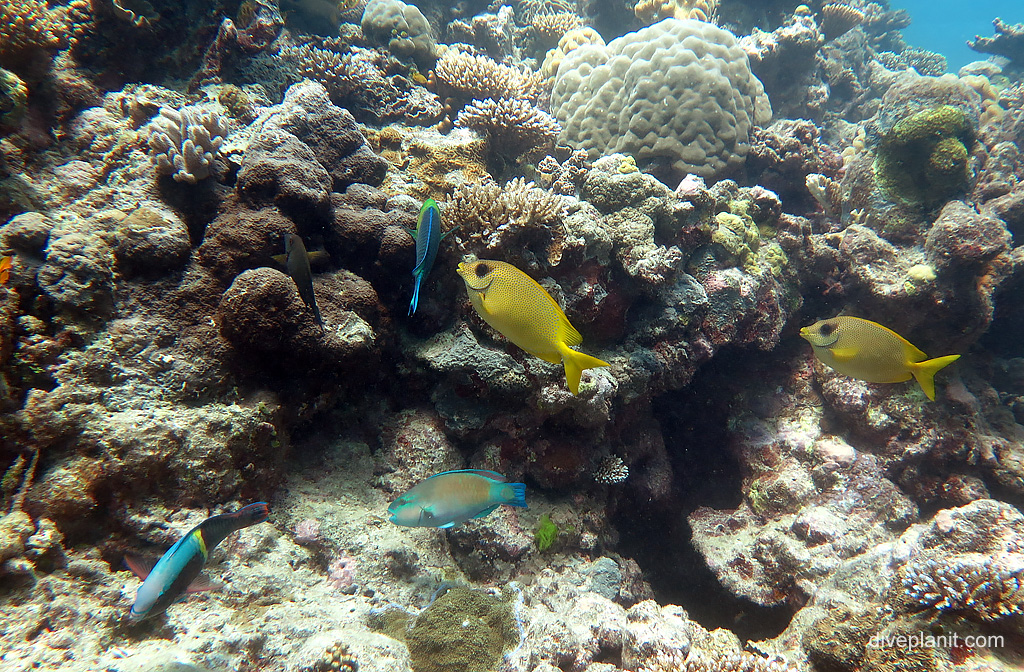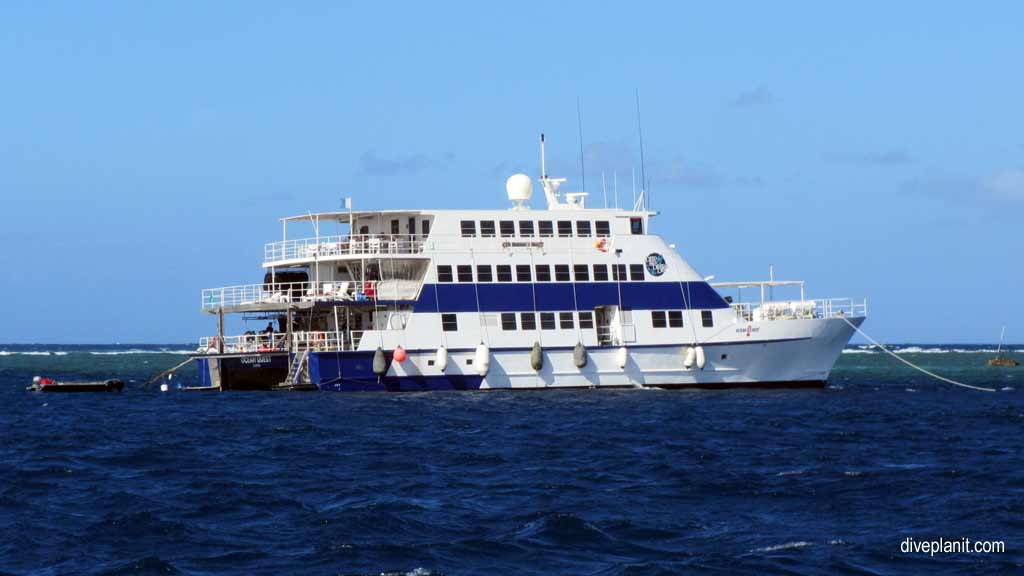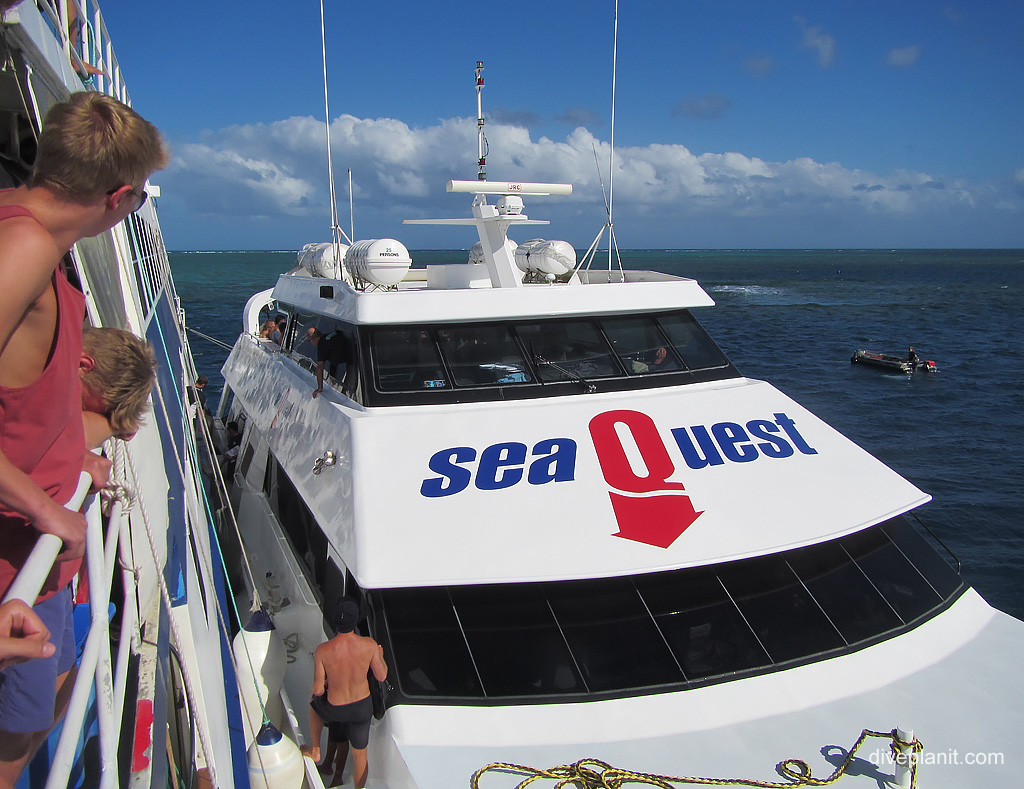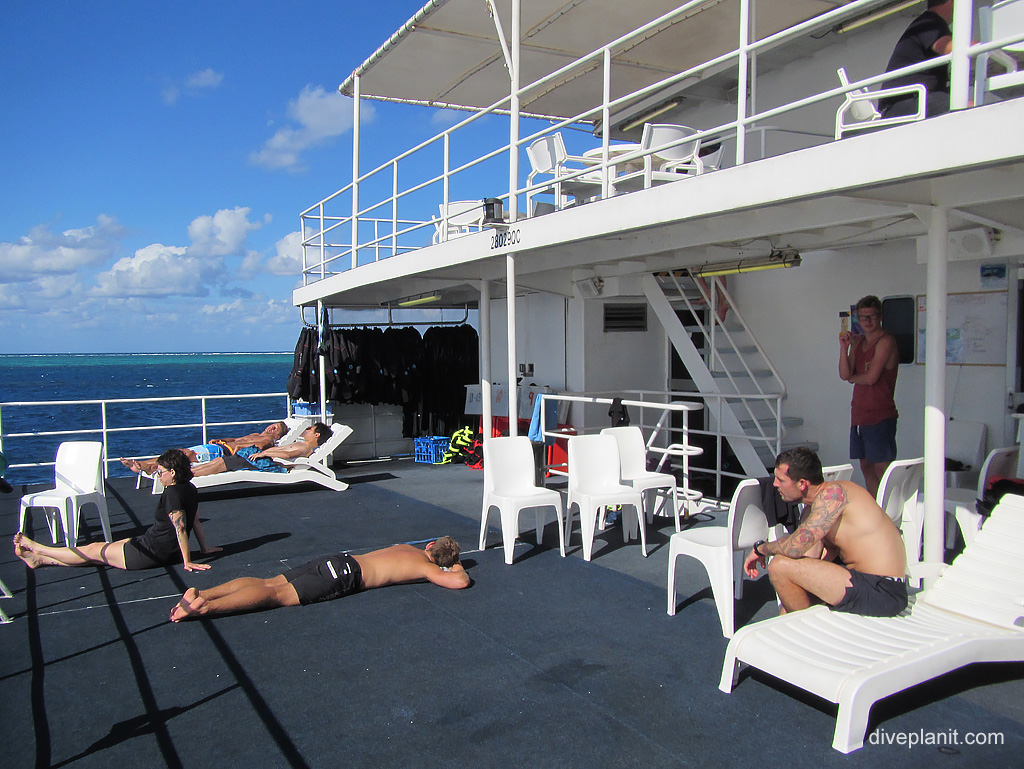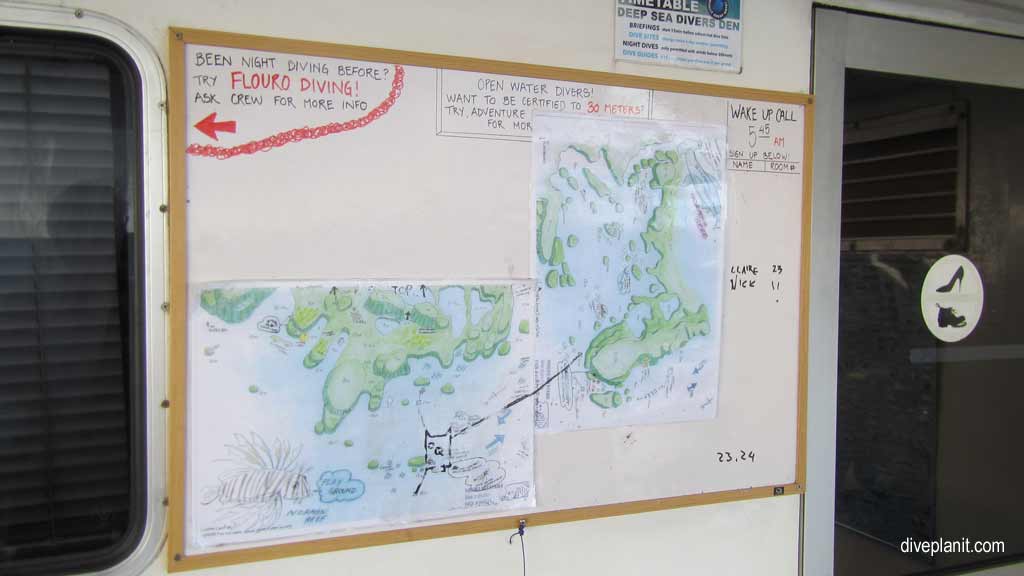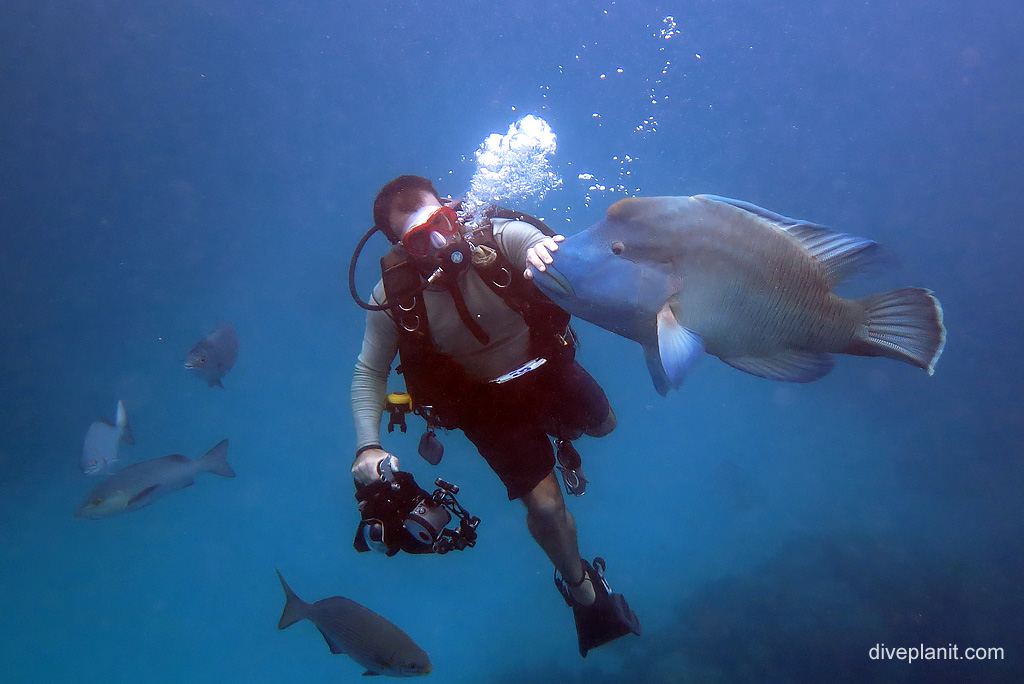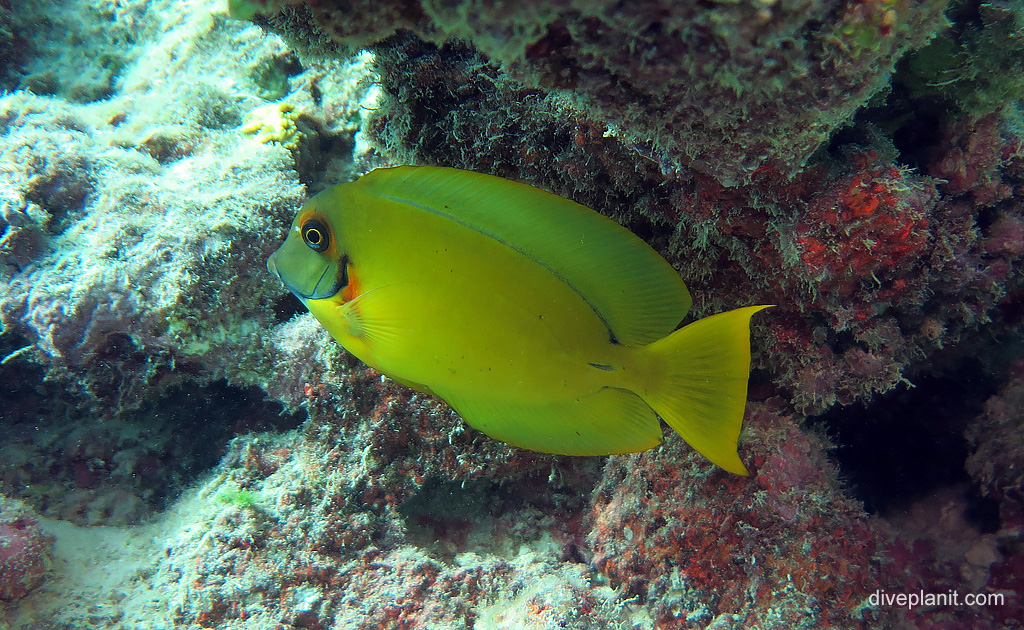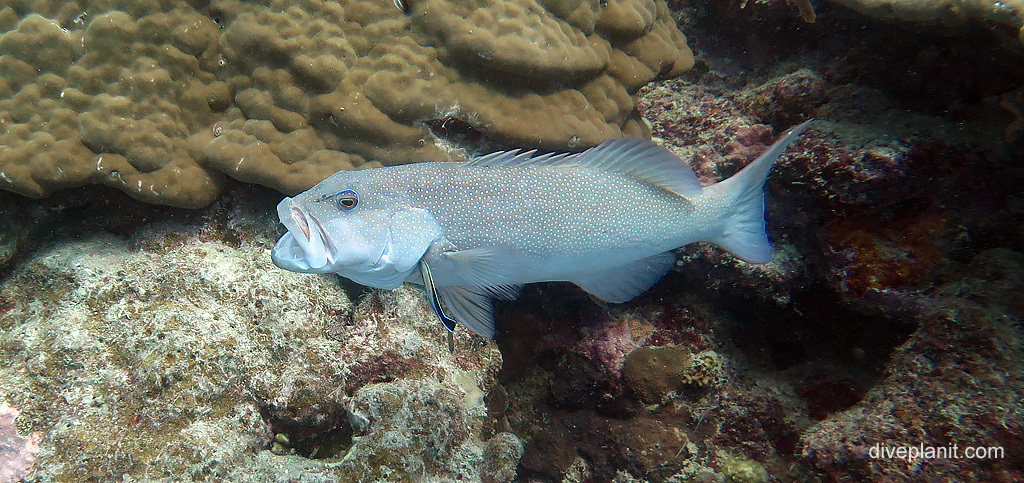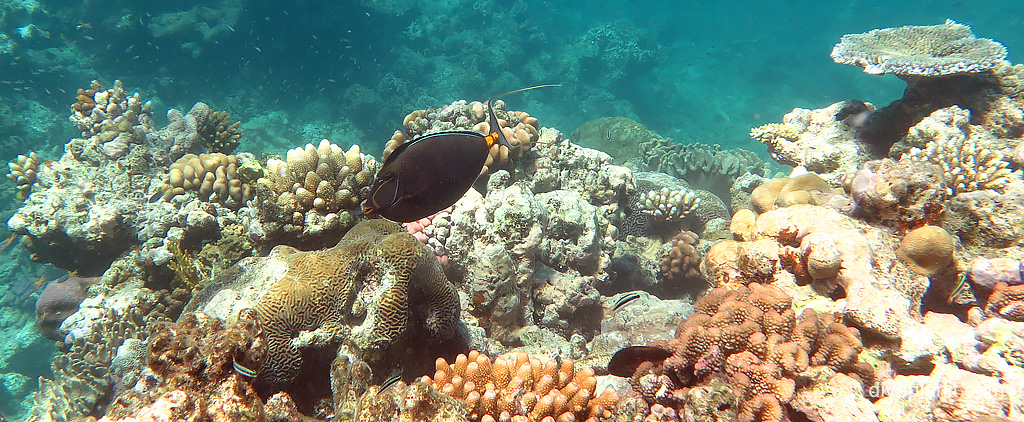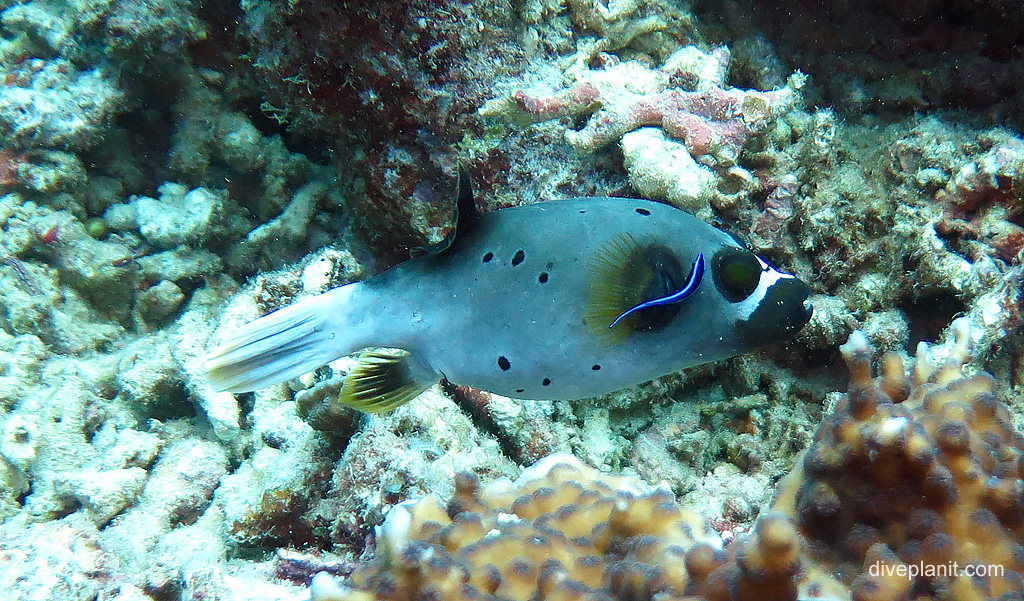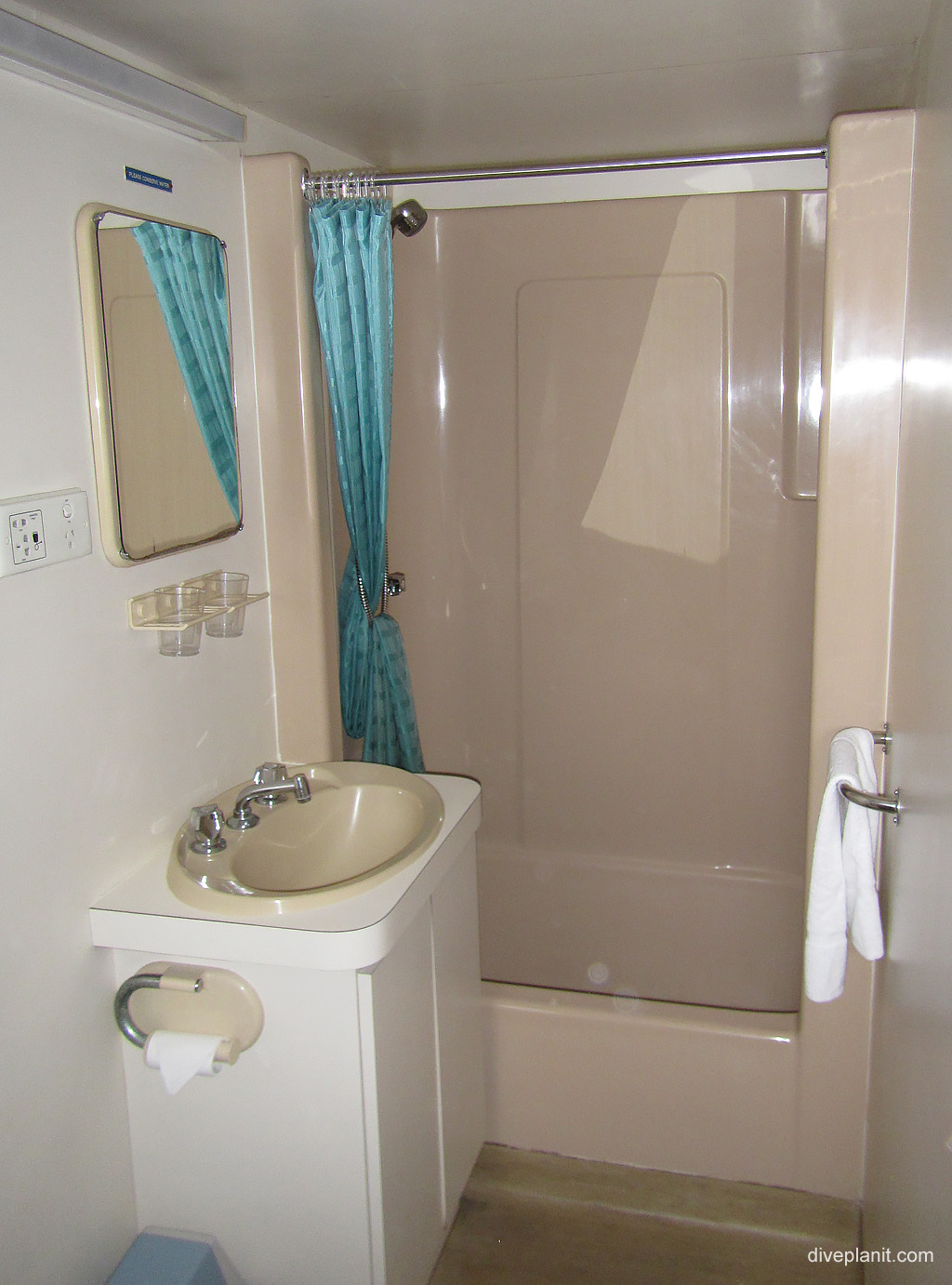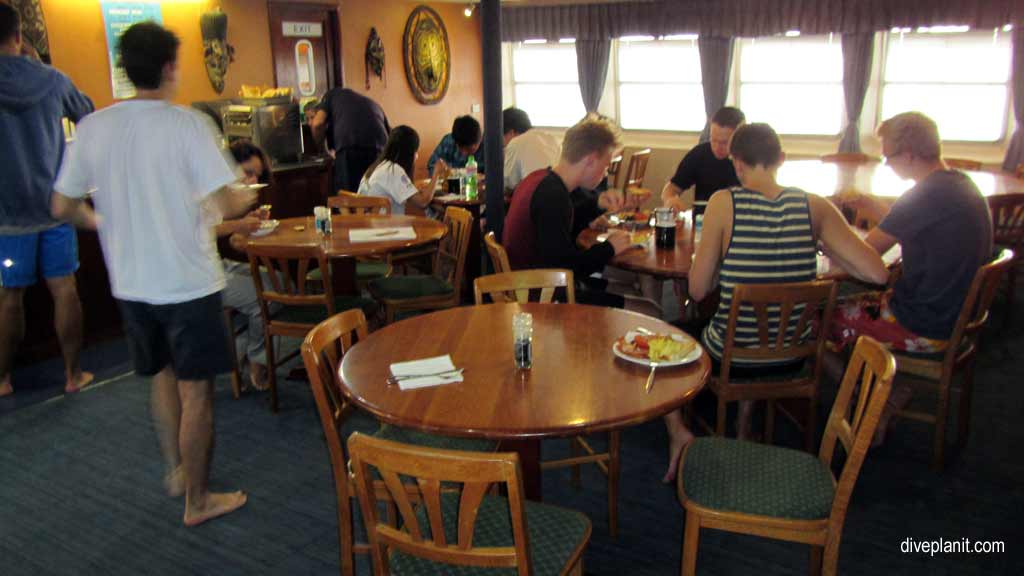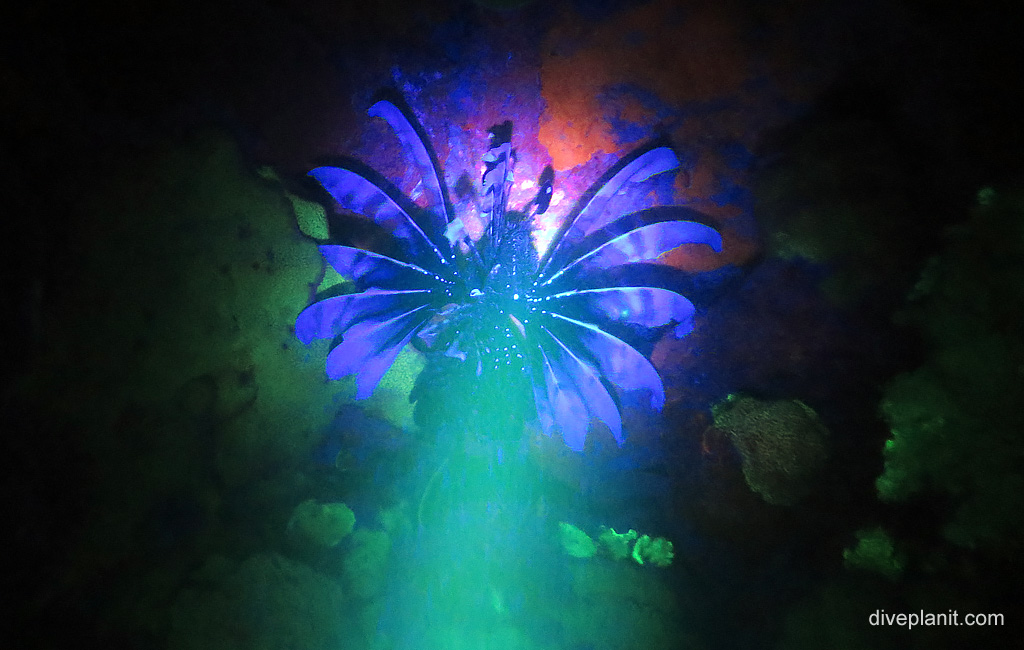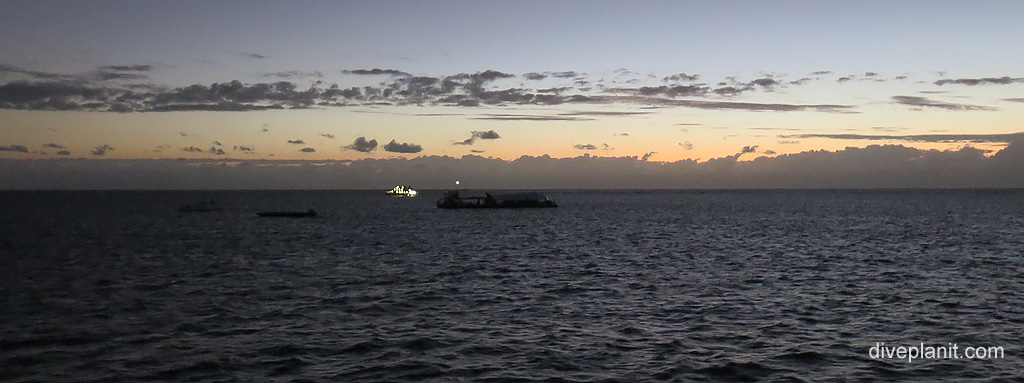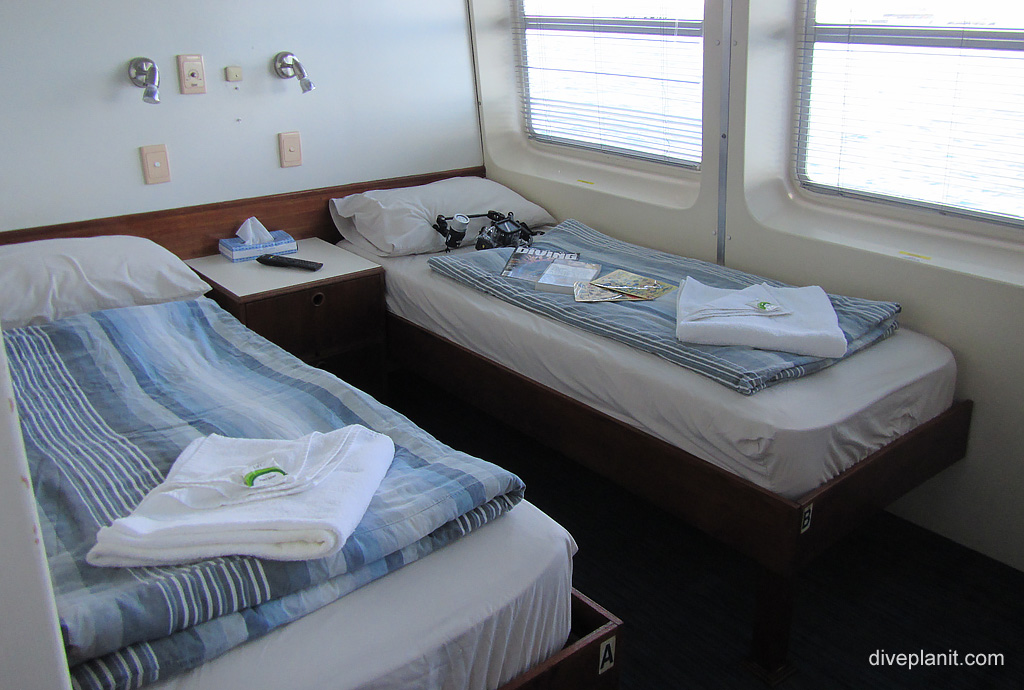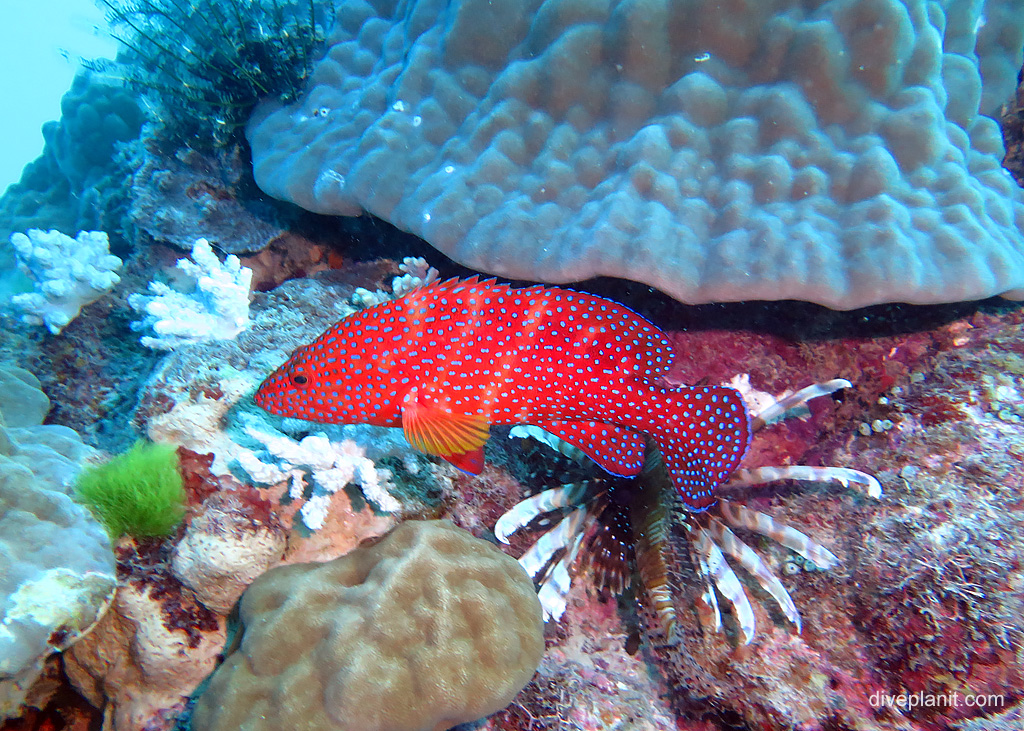The great thing about liveaboard diving is that you can become completely absorbed into the underwater world. Deep Sea Divers Den’s OceanQuest liveaboard doesn’t travel far but it provides a comfortable base on the outer reef to get in at least four dives a day. A few days out on the Reef is ample time to clear your mind completely of everyday trivia.
What do you think about when you’re diving? Certainly not next week’s shopping, not tomorrow night’s dinner, not even the next dive. You’re immersed in the here and now: the little screenplay that’s going on right in front of you:
The bright yellow oval spot butterflyfish picking at the algae on their way through, followed purposefully by a green bird nose wrasse, and maybe a silver scalyfin comes to check you out before returning to the shelter of the coral.
On the coral crown to the left a small tribe of headband humbugs rise above the coral fingers, assuming it’s safe to come out now that all is still outside. Up to the right a spotted sweet lips, hovering perfectly still under a slight overhang of coral has been watching you.
You exhale.
Oh yes. That’s right you’re on the Great Barrier Reef. You glance quickly down: depth 13m, air remaining: 170 bar, no deco time: 77 min. Buddy is nearby on a bommie observing a clownfish in the anemone.
All is well with the world and before you know it, you’re back in the zone just watching, a gilded trigger has arrived, a couple of bicolour angels finally show themselves and a small flock of parrots enter stage right nibbling the algae from the reef as they come.
Rewind. How did we get to this little deep sea diver’s adventure?
There are so many options for diving the (Great Barrier) Reef it’s hard to know where to start, but if you’re serious about spending some quality time on the Reef then a few days aboard a Liveaboard is the only way to go.
Deep Sea Divers Den accommodates guests for the number of nights of their choosing, offers five dives per day, on two different dive sites from their liveaboard Ocean Quest which is moored permanently on the outer reef.
Your trip to Ocean Quest starts on the day boat SunQuest just like any other day trip to the reef. SunQuest is fully equipped for diving and you can enjoy two dives and a satisfying lunch.
The adventure really starts the moment you step aboard the OceanQuest. It’s not a luxury liner, but the Pacific Island wall hangings give it a sense of the exotic and the wood panelled dining room a sense of permanence.
You stop feeling like a tourist trying to fill every minute of the day and more like a resident of the Reef. The pace slows as you change down a gear.
The boat is perfectly functional: three decks: cabins at the front, open decks at the back. Dive deck at the waterline, spacious sundeck behind the dining room above it, and above that the bar and lounge and the open moon deck.
During our welcome, tea and cake is served, and the boat briefing begins. The dive and meal schedule is on a big poster in the dining room and a polite little A4 poster in every other room including my cabin, so already I’m not listening.
Instead, I’m gazing out the window at the Reef and unconsciously I’ve already switched down another gear. Before we know it we are all on the sundeck listening to the briefing for dive 4 of the day.
The maps are pretty detailed and the mooring lines fan out from all corners of the large stable catamaran to anchor blocks almost at the foot of the reef wall – in this case the Norman Reef, which runs from left to right in front of the boat with another long parallel bommie behind it. We’re asked whether we’d like a guide: which a few opt for, the couples pair up and stragglers like me are buddied up.
Our group of divers are from the most diverse backgrounds, some old, some young, from almost every country speaking very different languages; but they all have one thing in common: their love of the ocean and what’s in it.
Their particular underwater interests vary from the steel hulks that men have accidentally lost, or the local residents of the massively complex ecosystems of ocean.
So it’s easy to strike up conversation with a fellow diver and I try my best to make it a habit – mainly to understand why they are there. Some are here to cover every square inch of the reef, some are chasing an elusive fish, some are just passing time. Their diving mirrors their life.
Of the guests on board, there’s a seismic hydrologist from Perth, a quality manager from Munich, both of whom are here just to be here on the reef and so would make the right buddy for me. I stand between them, so that when we’re buddied off, I’m paired with one or the other, and we nod in agreement, before studying the dive site map in greater detail.
I brought my own suit but it wasn’t really necessary – in fact it’s probably better to use the suits provided as you stand more chance of getting a dry suit by taking the next one along the rack on each subsequent dive rather than re-using your own that has only been out of the water for two hours.
Our gear, the regs and computers that we used on the day boat, are all assembled and waiting for us. We slip into that other mind state as we methodically check gauges, regs, taste our air, slide into BCDs and work the buddy check. We have already agreed to meet at 5m and so buddy and I drop straight off the platform, give the okay at five and start the dive.
Some reefs along the Great Barrier Reef are isolated bommies surrounded by deserts of sand, others are walls of reef with a few sandy pathways that lead into shallower, sheltered areas. The Norman Reef is the latter, and as usual the most interesting stuff is between 8 and 16 m.
I add a dozen new fish photos to my collection and everywhere you look there are cleaning stations. I even captured a nice shot of a spotted puffer with his cleaning wrasse.
After the dive, there’s excited chatter about who saw what where and plans to go there again tomorrow morning. There’s time for a hot shower in the en-suite bathroom and I make an effort to dress for dinner, well let’s say my shirt has a collar, making me and the staff in their neat polo shirts the exception.
Dinner is plated in the kitchen and served by the staff to the tables, where the conversation turns to the night dive: there’s the option of the shark dive or the fluoro- dive. I opt for fluoro just to try something different.
Fluoro diving is being offered by some operators, not just as a novelty, but as a different way of viewing life on the reef. Fluorescence is when living organisms absorb light of high energy (shorter wavelength) and re-emit light of lower energy (and therefore longer wavelengths).
In this case, ultraviolet is the input light, and this is re-emitted as light in the visible spectrum. (Not to be confused with phosphorescence – ability to store light, and re-emitted it over a longer period – that we know from dive instruments or glow-in-the-dark watch dials).
Most living organisms, including coral stand out vividly in the blue end of the visible spectrum, others extend into the red. Bleached corals – those with no living coral polyps stand out as deathly white in stark contrast to the techno colours of the living reef. Some have likened fluoro diving to the night scene from the movie Avatar.
By the time we arrive on the dive deck the sea behind the boat is a wild heaving mass of trevally, big snapper and sharks. The shark dive group slips quietly into the water working their way down along the almost horizontal mooring line, the swinging beams of their dangling torches reaching the seabed in the clear dark water like gigantic white stilts.
Then it’s our turn to descend, waving our fluoro torches like blue lightsabers we descend to Lionfish Bommie to see the reef in all its fluorescent glory. The reef that is a pale blue in the redless sunlight, and a deep purple-red in the white light of a dive torch becomes alive with deep fluorescent colours.
Trevally with stark blue outlines dart through our torch beams, brown and white lionfish become bright blue disco queens, and even the orange and white banded cleaner shrimp appear to come out in disco gear.
After the night dive our dessert is served – a nice warm fruit bake with ice cream (no chance of being even the slightest bit hungry on this boat) and finally it’s time to retire to the moon deck for a beer or two, where it’s still about 26° and a gentle breeze is blowing – no moths, no mozzies, no other annoyances. The only sound is the gentle lapping of the ocean against the boat as we all discuss the day’s dives.
The next day our 5:45am knock at the door comes all too soon, and I reluctantly trade my comfy bunk for a damp wetsuit, but it’s warm on deck and the golden glow to the east and clear blue skies overhead promise another great day’s diving.
Last night’s dessert fuels us through the first dive and onto a buffet breakfast of “the works”, while the boat moves to another mooring and we eagerly await the next dive briefing to find new sites and routes to explore.
By the third dive of the day I’m here in that zone. It’s just me, my buddy, the Reef. Watching the fish; butterflies in pairs, little schools of damsels, solitary surgeons, and the camouflage cod sitting in plain sight (he really does believe he’s invisible).
I wonder why coral trout always turn away, bannerfish spend their time upside down, and bicolour angels flee. A red fire dartfish plays hide and seek with me and a slingjaw wrasse comes by for a clean.
Too bad I only booked one night on the OceanQuest liveaboard – I could stay here for a week.

